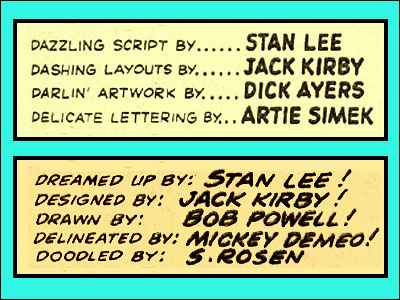What I wrote here the other day about Jack Kirby doing layouts at Marvel in the sixties quickly brought a whole lotta questions. I'll start with this one from Paul Dushkind and also give some of the back story…
I'm surprised to read that Jack Kirby refused to draw layouts after a while. I knew that his workload got smaller as time went on. You've created the impression that he aspired to lay out for other artists later, when he was at DC. Can you elaborate on this?
It's pretty simple. As Marvel expanded their super-hero line in the sixties, they needed more artists who could draw super-heroes in the new style and who could work — as Stan was insisting everyone work on the comics he was ostensibly writing — from a rough plot. Except that by then, Jack was generally supplying all or most of the plots on the comics they did together.
Very few artists who sought work at Marvel then could do what Kirby and Ditko and just a few others did, which was to take one of Stan's rough plots — which could be as sparse as one or two sentences and have originated with the artist in the first place — and turn it into 10 or 20 pages of penciled art for which Stan could then write dialogue. Joe Orlando quit after just a few stories because he'd pencil the story out, bring it in and Stan would make him (he claimed) redraw half the story. There was nothing wrong with the pictures Joe drew. They were just the wrong pictures, Stan felt. He didn't like the way Joe had developed the story they'd discussed.
Joe quit because he felt what Marvel paid then wasn't sufficient for drawing a story and then redrawing half of it. Some of the other guys didn't work out from Stan's viewpoint. He wasn't happy with what Carl Burgos or Bob Powell handed in, for example, which is why those two men didn't stick around longer. A few other artists who were given a few pages to "try out" didn't even last to the end of those stories and their samples were not paid-for by Stan or published.
For about two years, Stan dealt with this problem by having Kirby "lay out" a story which meant Jack applied his formidable plotting skills to it too. Stan may have had trouble dialoging a story Powell penciled on his own but the results were better (and easier) when Kirby laid it out and Powell penciled over those layouts.
It also helped "teach" some artists how to pace a story Marvel-style and get in swing with the characters. When Stan asked Alex Toth to take over from Kirby penciling X-Men, Alex couldn't just jump in and do it. He was unfamiliar with the strip, the characters and the ongoing storylines…and also, Alex wanted to understand the kind of storytelling Stan was seeking. So at Alex's request, Kirby laid out Alex's first story…which turned out to be Alex's only story because he was not comfortable doing the kind of work Stan was seeking.

Jack didn't like doing this kind of work but he felt he was helping the company — he still felt that if Marvel succeeded, he would reap some of the financial benefits — and he was also helping artists who needed help. When John Romita (Senior) was assigned to take over Daredevil, he drew the first few pages of his first issue like the romance comics he'd been doing for DC Comics. That wasn't the kind of storytelling Stan wanted in his super-hero books so he called on Jack to lay out the rest of the issue and all of the next so Romita could learn on the job.
Kirby did a number of stories this way for The Avengers and The X-Men and for Hulk stories in Tales to Astonish, Captain America stories in Tales of Suspense and Nick Fury, Agent of S.H.I.E.L.D. in Strange Tales. In a few cases, he veered more into complete penciling on key pages or the occasional panels.
But while he was always willing to help a fellow artist, Jack wasn't willing to do this forever for what he considered insufficient pay. He felt that to plot and layout a story was at least 50% of the important work on one of those pages — maybe more than 50% — but he was never paid close to that fraction. It was more like 25%. The publisher was unwilling to pay more for a penciled page that was laid-out by one guy and tight-penciled by another than he was for a penciled page that was wholly the work of one guy. And you couldn't pay Jack 50% of the money allotted for penciling and then expect anyone good to finish the art for the other 50%.
So Jack kept cutting back on his willingness to do such work and finally, after about two years, refused altogether. When he went to DC, he wanted to work with other artists but not in the same way, though we did experiment with one story for which Jack did layouts and Mike Royer did finished art. It was "The Psychic Bloodhound," which was intended for Spirit World #2 but which wound up being printed in Forbidden Tales of Dark Mansion #6. It turned out to not be a good way to divide up the work or the money and it was never attempted again.
I received a few more questions about Jack's layout work and I'll get to them in the next few days.
